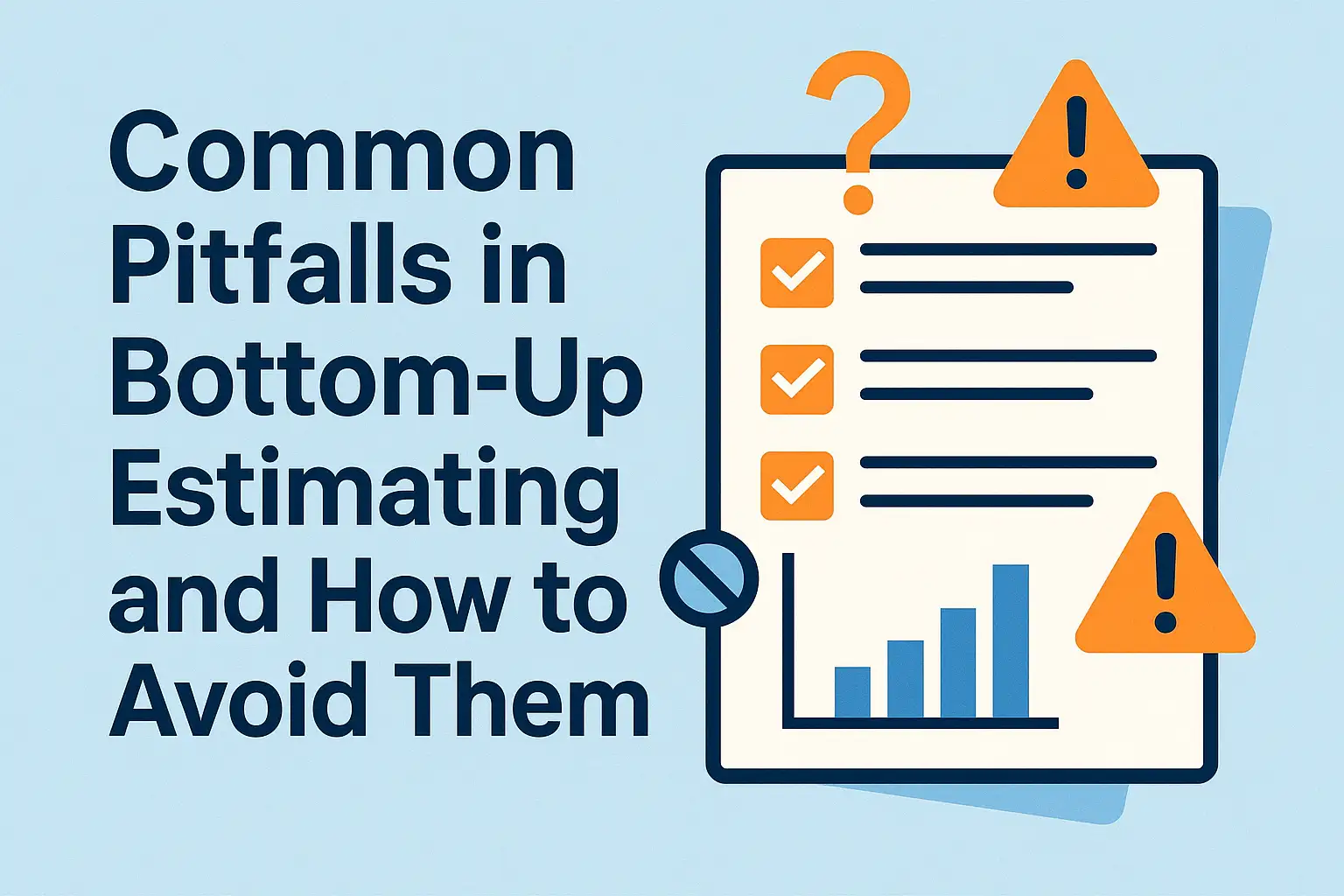Introduction to Bottom-Up Estimating
Bottom-up estimating is a project management technique that involves estimating the costs, durations, and resource requirements of a project at a granular level. This method breaks down the project into smaller, manageable components, allowing each element to be individually estimated and then aggregated to form a comprehensive estimate for the entire project. This approach is particularly beneficial for complex projects where accuracy is critical, as it provides a detailed view of the project’s scope and requirements [1][3].
Accurate estimation is vital for the success of any project. It not only helps in budgeting and resource allocation but also plays a crucial role in setting realistic timelines and expectations. When project managers have a clear understanding of the costs and durations involved, they can make informed decisions, mitigate risks, and enhance overall project performance. Inaccurate estimates can lead to budget overruns, missed deadlines, and ultimately, project failure [2][10].
Bottom-up estimating stands out from other estimating techniques, such as top-down estimating, which relies on overall project parameters to derive estimates. While top-down estimating may be quicker and less detailed, it often lacks the precision that bottom-up estimating provides. The latter allows for a more thorough analysis of each component, ensuring that all aspects of the project are considered and accounted for [1][14]. This detailed approach not only enhances accuracy but also fosters transparency, as stakeholders can easily understand how estimates were derived [7].
Understanding Common Pitfalls in Bottom-Up Estimating
Bottom-up estimating is a detailed approach in project management that involves breaking down a project into smaller, manageable components, allowing for individual estimation of each element. While this method can enhance accuracy, it is not without its challenges. Here are some common pitfalls that project managers may encounter during the bottom-up estimating process, along with strategies to overcome them:
- Inaccurate Work Breakdown Structure (WBS): A well-defined WBS is crucial for effective bottom-up estimating. If the WBS is flawed or incomplete, it can lead to significant inaccuracies in estimates. To avoid this, project managers should ensure that the WBS is thoroughly reviewed and validated by the team, incorporating all necessary components and tasks to provide a comprehensive view of the project scope [1][10].
- Overlooking Resource Availability and Skills: Often, project managers may underestimate the importance of aligning tasks with the right resources. Failing to consider the availability and specific skills required for each task can lead to unrealistic estimates. To mitigate this risk, it is essential to involve team members in the estimating process, as they can provide insights into their capabilities and availability, ensuring that estimates are grounded in reality [2][10].
- Underestimating Task Durations and Costs Due to Optimism Bias: Optimism bias can lead project managers to underestimate the time and costs associated with tasks. This can result in budget overruns and missed deadlines. To counteract this bias, it is beneficial to incorporate a buffer into estimates and to use historical data from similar projects to inform more realistic expectations [3][12].
- Lack of Stakeholder Involvement: Involving stakeholders in the estimating process is vital for capturing all necessary information and perspectives. A lack of engagement can result in incomplete estimates that do not reflect the full scope of the project. Project managers should actively seek input from stakeholders throughout the estimating process to ensure that all relevant factors are considered [4][10].
- Failure to Incorporate Historical Data from Past Projects: Historical data can provide valuable insights into potential costs and durations based on previous experiences. Ignoring this data can lead to inaccuracies in estimates. Project managers should make it a practice to review past project data and lessons learned, integrating this information into the current estimating process to enhance accuracy and reliability [5][12].
By recognizing these common pitfalls and implementing strategies to address them, project managers can improve the accuracy of their bottom-up estimates, ultimately leading to more successful project outcomes.
Pitfall 1: Inaccurate Work Breakdown Structure (WBS)
A Work Breakdown Structure (WBS) is a crucial tool that helps in organizing and defining the total scope of a project. It breaks down the project into smaller, manageable components, allowing project managers to estimate costs and durations more accurately through a bottom-up estimating approach. An accurate WBS is essential because it serves as the foundation for all subsequent project planning and execution activities.
Importance of WBS in Bottom-Up Estimating
- Clarity and Structure: A well-defined WBS provides clarity on project deliverables and tasks, ensuring that all team members understand their responsibilities. This clarity is vital for accurate estimation, as it allows for a detailed assessment of each component’s requirements [1].
- Comprehensive Coverage: By breaking down the project into smaller parts, a WBS ensures that no critical tasks are overlooked. This comprehensive coverage is necessary for accurate cost and time estimations, as missing elements can lead to significant underestimations [1][2].
- Facilitates Resource Allocation: An accurate WBS helps in identifying the resources needed for each task, which is essential for effective budgeting and scheduling [1].
Common Mistakes in Creating a WBS
- Overly Broad Categories: One common mistake is creating categories that are too broad, which can obscure the details necessary for accurate estimation. This can lead to a lack of clarity about what is included in each category, resulting in potential omissions [2].
- Neglecting Task Complexity: Failing to account for the complexity of tasks can lead to underestimating the time and resources required. Project managers may overlook potential challenges that could arise during execution [3].
- Inadequate Stakeholder Input: Not involving key stakeholders in the WBS creation process can result in missing critical insights and requirements. This oversight can lead to an incomplete or inaccurate WBS [2][3].
Strategies for Developing an Accurate and Comprehensive WBS
- Engage Subject Matter Experts: Involving experts who understand the intricacies of the project can provide valuable insights into task complexities and potential pitfalls. Their experience can help ensure that all aspects of the project are considered [4].
- Use a Hierarchical Structure: Organize the WBS in a hierarchical manner, starting from the highest level of deliverables and breaking them down into smaller, more detailed components. This structure helps in maintaining clarity and ensures that all tasks are accounted for [4][5].
- Regularly Review and Update: The WBS should be a living document that is regularly reviewed and updated as the project progresses. This practice helps in identifying any changes in scope or new tasks that may arise, ensuring that the WBS remains accurate throughout the project lifecycle [5].
- Utilize Project Management Tools: Leverage project management software that can assist in creating and maintaining a WBS. These tools often come with templates and features that facilitate collaboration and ensure that all team members can contribute to the WBS development [5].
By addressing the common pitfalls associated with an inaccurate WBS, project managers can enhance the reliability of their bottom-up estimating process. This proactive approach not only leads to more accurate estimations but also contributes to the overall success of the project.
Pitfall 2: Overlooking Resource Availability
Bottom-up estimating is a powerful technique that allows for detailed and accurate project cost and duration estimates. However, one of the most significant pitfalls that project managers and newcomers often encounter is the oversight of resource availability. This oversight can lead to skewed estimates and ultimately impact project success. Here’s a closer look at this challenge and how to effectively address it.
The Impact of Overlooking Resource Availability
When project managers fail to consider the availability of resources during the estimating process, it can lead to several issues:
- Skewed Estimates: If the estimates are based on the assumption that all required resources will be available when needed, the project may face delays if those resources are not actually accessible. This can result in underestimating the time and costs associated with the project, leading to budget overruns and missed deadlines [2][11].
- Skill Mismatches: Another critical aspect of resource availability is the skill set of the team members. If the project requires specific expertise that is not available within the team, it can lead to inefficiencies and increased timelines. For instance, if a project relies on advanced technical skills that the assigned team members do not possess, the project may experience significant delays as new resources are recruited or existing team members undergo training [4][15].
Methods for Accurately Assessing Resource Availability and Skill Sets
To mitigate the risks associated with overlooking resource availability, project managers can adopt several strategies:
- Conduct a Resource Inventory: Before beginning the estimating process, project managers should conduct a thorough inventory of available resources, including personnel, equipment, and materials. This inventory should detail not only the quantity of resources but also their current commitments and availability for the project [10][14].
- Skill Assessment: Alongside resource inventory, it is essential to assess the skill sets of team members. This can be done through skills matrices or competency assessments that identify the strengths and weaknesses of the team. Understanding the skills available will help in assigning tasks appropriately and ensuring that the right people are working on the right components of the project [3][15].
- Engage in Continuous Communication: Maintaining open lines of communication with team members and stakeholders can provide insights into resource availability. Regular check-ins can help identify any changes in resource commitments or skill levels, allowing for timely adjustments to the project plan [4][11].
- Utilize Project Management Tools: Leveraging project management software can aid in tracking resource availability and skill sets. Many tools offer features that allow project managers to visualize resource allocation and identify potential bottlenecks before they impact the project timeline [10][12].
By recognizing the importance of resource availability and implementing these strategies, project managers can enhance the accuracy of their bottom-up estimates, leading to more successful project outcomes. Addressing this pitfall not only helps in creating realistic timelines and budgets but also fosters a more efficient and effective project execution process.
Pitfall 3: Optimism Bias in Task Duration and Cost Estimation
In project management, optimism bias refers to the tendency of individuals to overestimate the likelihood of positive outcomes while underestimating the potential for negative events. This cognitive bias can significantly impact the accuracy of project estimates, leading to unrealistic timelines and underestimated costs. Understanding and addressing optimism bias is crucial for project managers and those new to the field to ensure successful project delivery.
Defining Optimism Bias and Its Effects on Project Estimating
Optimism bias is a common psychological phenomenon where individuals believe that they are less likely to experience negative events compared to others. In the context of project estimating, this bias can lead to:
- Underestimation of Task Durations: Project managers may assume that tasks will take less time than they realistically will, often ignoring potential delays or complications.
- Underestimation of Costs: Similarly, optimism bias can result in overlooking costs associated with risks, resources, and unforeseen challenges, leading to budget overruns.
The effects of optimism bias can be detrimental, resulting in project delays, increased costs, and ultimately, project failure if not addressed properly.
Examples of How Optimism Bias Manifests in Projects
Optimism bias can manifest in various ways during the project lifecycle:
- Overly Ambitious Timelines: A project manager might set a completion date that is significantly shorter than what is feasible, believing that the team will work more efficiently than past experiences suggest.
- Ignoring Historical Data: When estimating costs, project managers may disregard historical data from similar projects that indicate higher expenses, instead assuming that the current project will be less costly.
- Underestimating Resource Needs: Teams may assume that they can achieve project goals with fewer resources than necessary, leading to burnout and decreased productivity.
These examples highlight the importance of recognizing optimism bias in order to create more realistic project estimates.
Techniques to Combat Optimism Bias
To mitigate the effects of optimism bias in project estimating, project managers can employ several techniques:
- Utilize Historical Data: Analyzing data from previous projects can provide valuable insights into realistic timelines and costs. By comparing similar projects, managers can better understand potential challenges and resource needs.
- Incorporate Expert Judgment: Engaging experienced team members or external experts can help provide a more balanced perspective on task durations and costs. Their insights can counteract overly optimistic assumptions.
- Implement Risk Assessment: Conducting a thorough risk assessment can help identify potential pitfalls and their impacts on project timelines and budgets. By factoring in these risks, project managers can create more accurate estimates.
- Encourage Team Input: Involving the entire project team in the estimating process can help surface different perspectives and experiences, leading to more realistic estimates. Team members may have insights into potential challenges that a project manager might overlook.
By recognizing and addressing optimism bias, project managers can improve the accuracy of their estimates, leading to more successful project outcomes. This proactive approach not only enhances project planning but also fosters a culture of realistic expectations within the team.
Pitfall 4: Lack of Stakeholder Involvement
When employing bottom-up estimating techniques, the involvement of stakeholders is crucial for creating accurate and reliable estimates. This section will delve into the significance of stakeholder input, the risks associated with making estimates in isolation, and effective strategies for engaging stakeholders throughout the estimating process.
Importance of Stakeholder Input
- Enhanced Accuracy: Engaging stakeholders allows project managers to gather diverse perspectives and insights, which can lead to more precise estimates. Stakeholders often possess valuable knowledge about specific tasks, potential challenges, and resource requirements that may not be apparent to the project manager alone. This collaborative approach helps in identifying all necessary components of the project, thereby improving the accuracy of the estimates [1][9].
- Comprehensive Understanding: Stakeholders can provide context regarding project goals, constraints, and expectations. Their involvement ensures that the estimates reflect not only the technical aspects but also the strategic objectives of the project, leading to a more holistic view of what is required [10].
Risks of Making Estimates in Isolation
- Inaccurate Assumptions: When estimates are made without stakeholder input, project managers may rely on assumptions that do not align with reality. This can result in significant discrepancies between estimated and actual costs or durations, leading to budget overruns and project delays [14].
- Lack of Buy-In: Estimates created in isolation may lack the support of key stakeholders, which can lead to resistance during project execution. If stakeholders feel excluded from the estimating process, they may be less committed to the project, potentially jeopardizing its success [12].
- Missed Opportunities for Improvement: Without stakeholder feedback, project managers may overlook critical insights that could enhance the estimating process. This can lead to repeated mistakes and missed opportunities for refining estimation techniques in future projects [5].
Strategies for Engaging Stakeholders Effectively
- Regular Communication: Establishing open lines of communication with stakeholders is essential. Regular meetings, updates, and feedback sessions can help ensure that all parties are aligned and that their insights are incorporated into the estimating process [11].
- Workshops and Collaborative Sessions: Organizing workshops or collaborative sessions can facilitate brainstorming and discussion among stakeholders. This approach encourages active participation and allows for the sharing of ideas and concerns, ultimately leading to more accurate estimates [10].
- Utilizing Technology: Leveraging project management tools and software can enhance stakeholder engagement. These platforms can provide stakeholders with access to project data, enabling them to contribute their insights and track the estimating process in real-time [8].
- Feedback Mechanisms: Implementing structured feedback mechanisms allows stakeholders to voice their opinions and suggestions regarding estimates. This can include surveys, suggestion boxes, or dedicated feedback sessions, ensuring that their input is valued and considered [11].
Pitfall 5: Ignoring Historical Data
When employing bottom-up estimating techniques, one of the most significant pitfalls is the neglect of historical data. This oversight can lead to inaccuracies in project estimates, ultimately affecting timelines and budgets. Understanding the value of historical data and how to effectively utilize it can greatly enhance the accuracy of estimates.
The Value of Historical Data in Informing Estimates
Historical data serves as a critical resource for project managers, providing insights into past project performance, costs, and durations. By analyzing this data, project managers can:
- Enhance Accuracy: Historical data allows for more precise estimates by providing a benchmark based on previous projects. This can help in identifying realistic cost and time expectations, reducing the likelihood of overestimation or underestimation [1][2].
- Identify Trends: Analyzing past projects can reveal patterns in resource allocation, task durations, and potential risks. This information can be invaluable in predicting future project needs and challenges [3].
- Improve Decision-Making: Leveraging historical data enables project managers to make informed decisions based on empirical evidence rather than assumptions, leading to better project outcomes [4].
Gathering and Analyzing Historical Data from Past Projects
To effectively utilize historical data, project managers should follow these steps:
- Collect Data: Gather data from completed projects, including budgets, timelines, resource usage, and any issues encountered. This can be done through project management software, spreadsheets, or documentation from previous projects [5].
- Standardize Data: Ensure that the data collected is standardized for consistency. This may involve categorizing projects by size, complexity, or industry to facilitate easier comparisons [6].
- Analyze Data: Use statistical methods to analyze the data, looking for averages, variances, and trends. This analysis can help identify what worked well and what did not, providing a clearer picture for future estimates [7].
Tools and Methods for Integrating Historical Data into the Estimating Process
Several tools and methods can assist project managers in integrating historical data into their estimating processes:
- Project Management Software: Many project management tools come equipped with features that allow users to input historical data and generate reports. Tools like Microsoft Project, Asana, or Trello can help track past project metrics and facilitate easy access to historical data [8].
- Data Analysis Tools: Software such as Excel or more advanced analytics tools like Tableau can be used to analyze historical data. These tools can help visualize trends and patterns, making it easier to draw insights from the data [9].
- Lessons Learned Repository: Establishing a repository for lessons learned from past projects can be beneficial. This repository should include not only quantitative data but also qualitative insights that can inform future estimating processes [10].
By recognizing the importance of historical data and implementing strategies to gather, analyze, and integrate this information, project managers can significantly improve the accuracy of their bottom-up estimates. This proactive approach not only mitigates the risks associated with poor estimates but also enhances overall project success.
Strategies for Overcoming Pitfalls
Bottom-up estimating is a powerful technique in project management that involves estimating costs and durations at a granular level by breaking down the project into smaller components. However, this method can present several challenges that project managers must navigate to ensure accuracy and efficiency. Here are some actionable strategies to help project managers and newcomers avoid common pitfalls in bottom-up estimating:
- Encourage Regular Training and Workshops on Estimation Techniques: Continuous education is vital for enhancing the skills of project managers and their teams. Regular training sessions can help familiarize team members with the latest estimation techniques and best practices. This knowledge can lead to more accurate estimates and a better understanding of the complexities involved in the estimating process [11][14].
- Promote Collaborative Estimation Sessions with Team Members and Stakeholders: Engaging team members and stakeholders in the estimation process fosters a sense of ownership and accountability. Collaborative sessions allow for diverse perspectives, which can lead to more comprehensive estimates. By discussing assumptions and potential risks together, teams can identify gaps in their estimates and address them proactively [11][12].
- Implement a Review Process for Estimates to Identify Potential Issues Early: Establishing a systematic review process for estimates can help catch errors and inconsistencies before they become problematic. Regularly reviewing estimates with a focus on accuracy and feasibility can help project managers identify potential issues early on, allowing for timely adjustments and reducing the risk of cost overruns and missed deadlines [11][14].
- Utilize Project Management Software Tools that Facilitate Accurate Estimating: Leveraging technology can significantly enhance the accuracy of bottom-up estimates. Project management software tools often come equipped with features that allow for detailed breakdowns of tasks, historical data analysis, and risk assessment. These tools can streamline the estimating process, making it easier to track changes and updates, ultimately leading to more reliable estimates [11][12][15].
By implementing these strategies, project managers can effectively navigate the challenges associated with bottom-up estimating, leading to more successful project outcomes and improved stakeholder satisfaction.
Conclusion
In project management, accurate bottom-up estimating is crucial for ensuring project success. This technique allows project managers to break down complex projects into smaller, manageable components, leading to a more precise understanding of costs and durations. By estimating each task individually and aggregating these estimates, teams can create a comprehensive view of the project, which is particularly beneficial for intricate projects where precision is paramount [1][11].
However, as highlighted throughout this discussion, there are common pitfalls associated with bottom-up estimating that can hinder the accuracy of these estimates. Challenges such as time consumption, complexity, and the tendency to rely on gut feelings rather than data can lead to significant misjudgments [10][5]. It is essential for project managers to be aware of these risks and actively work to mitigate them. By implementing the strategies discussed, such as fostering transparency, engaging team members in the estimating process, and avoiding shortcuts, project managers can enhance the reliability of their estimates [2][6][10].
We encourage our readers, whether seasoned project managers or newcomers to the field, to apply these insights to their estimating processes. By doing so, they can not only improve the accuracy of their project estimates but also contribute to the overall success of their projects.
Find out more about Shaun Stoltz https://www.shaunstoltz.com/about/.
This post was written by an AI and reviewed/edited by a human.



